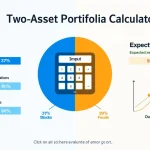Put-Call Parity Calculator
Is this tool helpful?
How to Use the Put-Call Parity Calculator Effectively
Our Put-Call Parity Calculator is designed to help you quickly and accurately determine the future price of an underlying asset based on the principles of put-call parity. To use this tool effectively, follow these simple steps:
- Enter the Call Price in USD: This is the current market price of the call option for the underlying asset.
- Input the Put Price in USD: Enter the current market price of the put option for the same underlying asset.
- Provide the Strike Price in USD: This is the predetermined price at which the option can be exercised.
- Click the “Calculate” button to obtain the future price of the underlying asset.
The calculator will instantly process your inputs and display the calculated future price, helping you make informed decisions in your options trading strategy.
Understanding Put-Call Parity: Definition, Purpose, and Benefits
Put-call parity is a fundamental concept in options pricing theory that establishes a relationship between the prices of European put and call options with the same underlying asset, strike price, and expiration date. This principle is crucial for maintaining equilibrium in options markets and preventing arbitrage opportunities.
The primary purpose of put-call parity is to ensure that the prices of put and call options are in a state of equilibrium relative to each other and the underlying asset’s price. This relationship can be expressed mathematically as:
$$C + PV(K) = P + S$$Where:
- C = Call option price
- P = Put option price
- PV(K) = Present value of the strike price
- S = Current price of the underlying asset
Our Put-Call Parity Calculator leverages this principle to determine the future price of the underlying asset, which is equivalent to S in the above equation. By rearranging the formula, we can calculate the future price as:
$$S = C – P + K$$Where K is the strike price, assuming the present value of the strike price is equal to the strike price itself (i.e., ignoring the time value of money for simplicity).
Benefits of Using the Put-Call Parity Calculator
Utilizing our Put-Call Parity Calculator offers numerous advantages for options traders, financial analysts, and investors:
- Quick and Accurate Calculations: Our tool eliminates the need for manual calculations, reducing the risk of errors and saving you valuable time.
- Market Insight: By determining the implied future price of an asset, you gain valuable insight into market expectations and potential mispricings.
- Arbitrage Opportunity Detection: The calculator helps identify potential arbitrage opportunities when put-call parity is violated in the market.
- Risk Management: Understanding the relationship between put and call prices aids in developing more effective hedging strategies.
- Educational Tool: For those learning about options trading, this calculator serves as a practical tool to reinforce the concept of put-call parity.
- Decision Support: The calculated future price can inform your trading decisions, helping you assess whether options are overvalued or undervalued.
Addressing User Needs and Solving Specific Problems
The Put-Call Parity Calculator addresses several key needs and solves specific problems faced by options traders and investors:
1. Validating Option Prices
By inputting current market prices for call and put options, users can verify if these prices adhere to the put-call parity principle. If the calculated future price significantly deviates from the current market price of the underlying asset, it may indicate mispricing in the options market.
2. Identifying Arbitrage Opportunities
When put-call parity is violated, arbitrage opportunities may arise. The calculator helps traders quickly identify these situations, allowing them to potentially profit from market inefficiencies.
3. Estimating Future Asset Prices
The calculated future price provides an estimate of where the market expects the underlying asset’s price to be at the option’s expiration. This information is valuable for both short-term traders and long-term investors in formulating their strategies.
4. Enhancing Options Pricing Models
For more advanced users, the put-call parity calculator can be used to cross-check the outputs of complex options pricing models, ensuring consistency and accuracy in their valuations.
5. Educational Support
Students and novice traders can use this tool to better understand the relationships between put options, call options, and the underlying asset price, reinforcing their theoretical knowledge with practical applications.
Practical Applications and Use Cases
To illustrate the practical applications of our Put-Call Parity Calculator, let’s explore some real-world scenarios:
Scenario 1: Detecting Mispriced Options
Suppose you’re analyzing options for XYZ stock with a current market price of $100. You observe the following:
- Call option (strike price $100) trading at $5
- Put option (strike price $100) trading at $3
Using our calculator:
- Call Price: $5
- Put Price: $3
- Strike Price: $100
The calculated future price is: $5 – $3 + $100 = $102
This result suggests that the options market is implying a slight increase in the stock price. If the current stock price is significantly different from $102, it might indicate a mispricing in either the options or the underlying stock.
Scenario 2: Arbitrage Opportunity
Consider a situation where you find the following prices for options on ABC stock, currently trading at $50:
- Call option (strike price $50) trading at $4
- Put option (strike price $50) trading at $2
Using our calculator:
- Call Price: $4
- Put Price: $2
- Strike Price: $50
The calculated future price is: $4 – $2 + $50 = $52
If the current stock price is significantly below $52, say $50, this could represent an arbitrage opportunity. Traders could potentially profit by buying the stock, buying the put option, and selling the call option.
Scenario 3: Estimating Market Expectations
Let’s say you’re analyzing options for DEF stock with a current price of $75:
- Call option (strike price $80) trading at $3
- Put option (strike price $80) trading at $6
Using our calculator:
- Call Price: $3
- Put Price: $6
- Strike Price: $80
The calculated future price is: $3 – $6 + $80 = $77
This result suggests that the options market expects the stock price to rise slightly from its current $75 to $77 by the option expiration date. This information can be valuable for investors considering whether to buy, hold, or sell the stock.
Frequently Asked Questions (FAQ)
1. What is put-call parity?
Put-call parity is a principle that defines the relationship between the prices of European put and call options with the same underlying asset, strike price, and expiration date. It ensures that these options are priced consistently relative to each other and the underlying asset.
2. How accurate is the Put-Call Parity Calculator?
Our calculator provides accurate results based on the inputs provided. However, it’s important to note that it assumes European-style options and doesn’t account for factors like dividends or interest rates. For more complex scenarios, additional adjustments may be necessary.
3. Can this calculator be used for American-style options?
While the calculator can provide a rough estimate for American-style options, it’s primarily designed for European-style options. American options may deviate from put-call parity due to the possibility of early exercise.
4. What does it mean if the calculated future price differs significantly from the current market price?
A significant difference could indicate several things: potential mispricing in the options market, arbitrage opportunities, or that the market expects significant changes in the underlying asset’s price. However, always consider other factors like dividends, interest rates, and market conditions before drawing conclusions.
5. How can I use this calculator to identify arbitrage opportunities?
If the calculated future price differs significantly from the current market price of the underlying asset, it might indicate an arbitrage opportunity. However, be cautious and consider transaction costs, risks, and other market factors before attempting to exploit such opportunities.
6. Does the calculator take into account dividends or interest rates?
No, this simplified version of the calculator does not account for dividends or interest rates. For a more precise calculation in scenarios involving significant dividends or over longer time periods, you would need to adjust the formula to include these factors.
7. Can I use this calculator for options on different types of assets?
Yes, you can use this calculator for options on various underlying assets, including stocks, indices, currencies, and commodities, as long as they are European-style options.
8. How often should I use this calculator when trading options?
It’s a good practice to use the calculator regularly as part of your options trading strategy, especially when evaluating new trades or reassessing existing positions. However, it should be used in conjunction with other analysis tools and market information.
9. What are the limitations of this calculator?
The main limitations include the assumption of European-style options, not accounting for dividends or interest rates, and not considering factors like volatility or time decay. It’s a useful tool for quick estimations but should not be the sole basis for trading decisions.
10. Is the calculated future price a prediction of where the asset’s price will be?
The calculated future price is not a prediction but rather an implication based on current option prices. It reflects the market’s collective expectation embedded in option prices, but actual future prices may differ due to various market factors.
Please note that we cannot guarantee that our webtool or the results from our webtool are always correct, complete, or reliable. Our content and tools might have mistakes, biases, or inconsistencies. Always use this calculator in conjunction with other research and professional advice for important financial decisions.
Conclusion: Empowering Your Options Trading Strategy
The Put-Call Parity Calculator is an invaluable tool for options traders, investors, and financial analysts. By quickly and accurately calculating the implied future price of an underlying asset, it provides crucial insights that can inform trading decisions, identify market inefficiencies, and enhance overall trading strategies.
Key benefits of using this calculator include:
- Rapid validation of option prices
- Detection of potential arbitrage opportunities
- Insight into market expectations for asset prices
- Support for risk management and hedging strategies
- Educational value for understanding options pricing dynamics
While the Put-Call Parity Calculator is a powerful tool, it’s important to remember that it should be used as part of a comprehensive approach to options trading. Always consider other factors such as market conditions, volatility, and your own risk tolerance when making trading decisions.
We encourage you to bookmark this page and make the Put-Call Parity Calculator a regular part of your options analysis toolkit. By leveraging this tool effectively, you can enhance your understanding of options pricing, make more informed trading decisions, and potentially improve your overall trading performance.
Start using our Put-Call Parity Calculator today and take your options trading strategy to the next level!
Important Disclaimer
The calculations, results, and content provided by our tools are not guaranteed to be accurate, complete, or reliable. Users are responsible for verifying and interpreting the results. Our content and tools may contain errors, biases, or inconsistencies. We reserve the right to save inputs and outputs from our tools for the purposes of error debugging, bias identification, and performance improvement. External companies providing AI models used in our tools may also save and process data in accordance with their own policies. By using our tools, you consent to this data collection and processing. We reserve the right to limit the usage of our tools based on current usability factors. By using our tools, you acknowledge that you have read, understood, and agreed to this disclaimer. You accept the inherent risks and limitations associated with the use of our tools and services.







